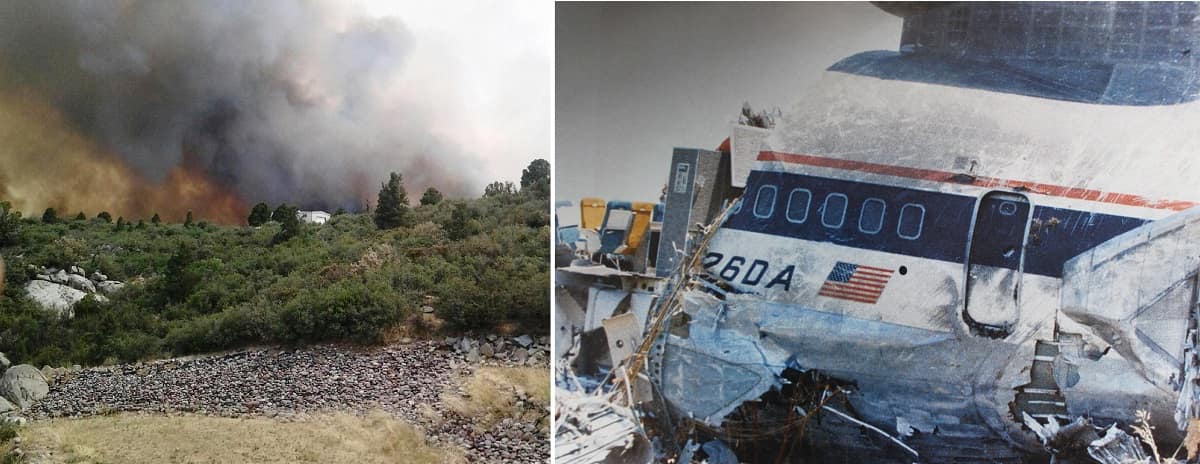NSF-Funded Research Sheds Light on Yarnell Hill Fire Tragedy

Nineteen firefighters who lost their lives in Arizona’s 2013 Yarnell Hill fire were likely victims of the same meteorological event that caused a deadly 1985 airplane crash, Embry-Riddle Aeronautical University researchers have reported.
City of Prescott firefighters who were members of the Granite Mountain Hotshots were probably surprised by a sudden microburst during the Yarnell Hill fire, according to Embry-Riddle meteorologists Curtis N. James and Michael Kaplan.
A microburst, and the wind shear induced by it, was also what sent a commercial airliner careening off the runway at Dallas/Fort Worth International Airport, killing 137 people on Aug. 2, 1985. That accident prompted major improvements in aviation safety. The National Transportation Safety Board concluded that there had been no way for the L-1011 aircraft to detect microbursts and wind changes. In response, NASA researchers developed new warning technology, and the U.S. Federal Aviation Administration required all commercial aircraft to have on-board wind shear detection systems.
Firefighters do not yet have equivalent protections.
Although microbursts can be detected by Doppler weather radar scanning right above the ground, radar signals are blocked over mountainous terrain or in remote areas where wildfires occur. With funding from the National Science Foundation, James and Kaplan have been collaborating with researchers and graduate students at North Carolina A&T University as well as the National Weather Service to better understand and learn from the tragedy of the Yarnell Hill fire.
On June 28, 2013, “Firefighters knew about the squall line over the Bradshaw Mountains and its outflow moving toward Yarnell,” said James, professor of Meteorology on Embry-Riddle’s Prescott Campus. “What they weren’t anticipating was that a storm cell would develop and create a microburst just to the east of Yarnell. We think the outflow from that microburst rushed westward toward the fire, which then redirected the fire’s motion.”
Microbursts can form very quickly around the periphery of larger, previously identified storms, explained Kaplan, an Embry-Riddle adjunct faculty member and professor emeritus with the Desert Research Institute. “When they hit the ground, microbursts barrel outward, often at high speeds,” added Kaplan, who worked on a team that studied the 1985 crash of Delta Air Lines Flight 191 in Texas.
The Yarnell Hill fire, ignited by lightning amid a drought and extreme summer temperatures, turned in response to the microburst outflow. The fire then rapidly and unexpectedly advanced on the firefighters as they were trying to make their way to safety through a ravine, James said. Analysis of historical meteorological data showed that wind on the north side of the fire, at the Emergency Operations Center, was moving from the north-northeast at 13 miles per hour (mph), whereas in Stanton, southeast of the fire, the wind was gusting to 47 mph.
“It was a very different situation on the south side versus the north side of the fire,” James noted. “Fine-scale convective storm cells can create that type of variability in the wind. That’s something the firefighters weren’t anticipating.”
Staying Safe on the Front Lines
First responders should have access to more information about microbursts, the Embry-Riddle researchers said. Even as an initial thunderstorm may seem to be waning, “It may spawn new storm cells that are extremely focused and intense, and incredibly small sometimes, yet they can wreak havoc,” Kaplan said.
To help raise awareness of the risks of microbursts, James and Kaplan recently shared their findings at the Annual Meeting of the American Meteorological Society. The work has also been published by the journal Climate and the journal Atmosphere.
The next step for the research, Kaplan said, is to run higher-resolution model simulations coupled with a fire behavior model. If all goes well, this “forensic meteorology” approach will show the motion of the fire as it moved through the complex terrain toward the firefighters at Yarnell Hill. At a resolution of 50 meters, “That would get us pretty close to the scale of what the firefighters actually saw that day,” Kaplan said. “That’s our goal.”
In addition to James and Kaplan, the research team includes Mark R. Sinclair, of Embry-Riddle; North Carolina A&T State University researcher Yuh-Lang Lin and his graduate students; and Andrew A. Taylor of the National Weather Service. The research involved the use of the Cheyenne supercomputer at the National Center for Atmospheric Research and is funded by the National Science Foundation.

 Ginger Pinholster
Ginger Pinholster